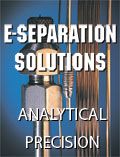The LCGC Blog: Unanticipated Benefits of Keyword Searching the Scientific Literature
E-Separation Solutions
If you ask scientists, it does not take long before you realize that there is quite a bit of variety in the different search engines that they prefer.
I am not the most computer savvy individual, but through a lot of practice I have become pretty good at searching the scientific literature. If you ask scientists, it does not take long before you realize that there is quite a bit of variety in the different search engines that they prefer. These days you can basically search anything or any content on any site. For finding papers on a subject, biologically oriented people tend to favor PubMed, but I have never really been a fan because it always seems difficult to find the way to directly get to the full paper. I think a lot of people like to search directly on Science Direct. Given the number of journals indexed there, that approach seems to work fairly well. In fact, in the past I liked to use a search engine called Scirus, which was run by Elsevier and would very easily allow you to select whether you wanted it to search for PubMed or Science Direct articles. I would always filter by Science Direct, because more often than not it provided an easy path to full articles from journals for which my institution had a subscription. Search results could be easily refined as you went along. I recommended Scirus quite a bit to my students and colleagues; however, late last year I went to visit Scirus and encountered a notice that said it was going to retire. I believe that it actually mentioned that a reason for this end had something to do with the success of Google Scholar, but I am not sure if I just imagined that or not. In any case, I was compelled to go and check out Google Scholar, and I have to say that there are many things that I really like about it — it is definitely my new “go to” search engine for scientific literature.
I like Google Scholar not just for its ability to search, but for its ability to collate my papers through a personalized page, to collate papers into a library on a particular topic I set, to track citations of my articles, and especially to send me email alerts when new articles are published that contain keywords that I have specified. Although I have not fully refined my alerts, one that I set on “hydraulic fracturing or unconventional drilling” has been extremely beneficial for keeping me up to date on that quickly evolving field of research. Of course, I am most interested in aspects of this topic related to environmental analysis and impact, but I have also been alerted to really interesting articles peripheral to this focus. I have enjoyed reading about the economic benefits of unconventional drilling. I have enjoyed reading about how the rest of the world is carefully evaluating how it can responsibly engage in this practice. I have enjoyed learning more about how the engineering has evolved to continually improve unconventional drilling. I believe this might be the first time my group has entered on the ground floor of a rapidly evolving field of research (1); it is absolutely crucial that I am constantly apprised of new publications that can inform and develop our work. This alert system certainly does the job — even this blog article will now appear in a forthcoming email alert to me.
I receive three other email alerts, and these also have some unanticipated benefits. One on “antibacterial drug discovery” brings a lot of interesting information on both the chemical and biological side of the topic. I am working together with others to develop an innovative educational program where freshman students at U.T. Arlington are collectively engaged in research in their first semester. The topic for the initial cohort, which I will help direct, will be natural product drug discovery, so this alert keeps us aware of the very newest research in the area. Communicating the absolute newest breakthroughs to the students should be extremely motivating and engaging for them. Another alert is based on “transmission mode–desorption electrospray ionization mass spectrometry” (TM-DESI), which is an ambient ionization technique we have helped develop in the recent past (2). Initially, I set this alert because very little work has been performed using this technique (the approach was first reported by the Brodbelt group at U.T. Austin [3]), and I wanted to know if any other groups started to use it. As far as I know, no one else has done much work using TM-DESI, but I have also been pleased to find out that this search string consistently yields a number of interesting articles in mass spectrometry research that I did not anticipate showing up in my alerts. For example, this keyword combination brings a lot of the recent work that is published on matrix-assisted laser desorption–ionization (MALDI) mass spectrometry. It also provides some interesting coverage of other ambient ionization techniques that I might otherwise miss. So, even though I have not received any alerts that pertain specifically to TM-DESI (of course, I would if they were published), I still have been reluctant to change or alter the search string because of the ancillary information it has provided.
The last search string is one that I have altered — and I did so rather quickly after I received the first set of alerts. I set an alert for “restricted access media,” because we have been doing a lot of work using this material to facilitate on-line sample preparation of biological fluids (4). Restricted access media combine size exclusion properties and standard chromatographic retention properties on the inner pores of particles. Now, interestingly, despite the exceptional performance of these materials, their use for on-line sample preparation still has relatively limited use compared to other sample preparation strategies, so I receive few alerts directly on this topic. That said, my initial setting of “restricted access media” brought some very unanticipated information. My first alert contained a cross between research on access to pornographic websites and freedom of the press; there was absolutely no chemistry, much less analytical chemistry, contained in any of the articles listed. While interesting, this result was a little further away from what I was looking for, and I frankly was a bit worried if some topics were found by others to be present in my work email. To remedy this situation, I quickly altered the alert request to “restricted access media and chromatography.” That seemed to fix the situation, but I do still receive some fairly uninteresting articles (to me) that are listed simply because they are posted in open access journals and somewhere mention the word chromatography. I will be excited as some recent submissions from our group become published in the Journal of Separation Science (JSS). I am co-editing a special virtual issue on sample preparation for mass spectrometry in JSS (5) together with Prof. Michael Laemmerhofer, and two of the articles that will be published in the issue feature our recent work on restricted access media.
So, for sure, I simply have to keep refining my search approach. At first, I felt dismay for the demise of a search engine that I had grown to be familiar with and trust. Yet, as I changed to new technology, I have to say that I have been nothing but pleased. I am sure that there are other excellent search engines out there, and even though I have never heard of them at this point, perhaps one day I will be compelled to use them. But for now, I will stick with Google Scholar; if you have never used it, I recommend you check it out — and if you receive some highly unanticipated search results from your keyword searches, let me know about them. I am always up for a good laugh. Cheers!
References
(1) B.E. Fontenot, L.R. Hunt, Z.L. Hildenbrand, D.D. Carlton Jr., H. Oka, J.L. Walton, D. Hopkins, A. Osorio, B. Bjorndal, Q. Hu, and K.A. Schug, Environ. Sci. Technol. 47, 10032–10040 (2013).
(2) S.H. Yang, E.H. Wang, J.A. Gurak, S. Bhawal, R. Deshmukh, A.B. Wijeratne, B.L. Edwards, F.W. Foss Jr., R.B. Timmons, and K.A. Schug, Langmuir 29, 8046–8053 (2013).
(3) J.E. Chipukand J.S. Brodbelt, J. Am. Soc. Mass Spectrom. 19, 1612−1620 (2008).
(4) S.H. Yang, H. Fan, R.J. Classon, and K.A. Schug, J. Sep. Sci. 36, 2922–2938 (2013).
(5) http://onlinelibrary.wiley.com/journal/10.1002/(ISSN)1615-9314/homepage/sample_preparation_in_mass_spectrometry.htm
Previous blog entries from Kevin Schug:
The LCGC Blog: A Report from Riva del Garda: The Current State of the Art of Gas Chromatography
The LCGC Blog: Basics, Applications, and Innovations in Solid-Phase Extraction
The LCGC Blog: My Own March Madness
The LCGC Blog: A View of Separation Science Research at a Czech Conference
The LCGC Blog: What is the Optimal Training to Provide Students Interested in a Career in Industry?
The LCGC Blog: A Closer Look at Temperature Programming in Gas Chromatography
The LCGC Blog: Back to Basics: The Role of Thermodynamics in Chromatographic Separations
The LCGC Blog: The Dimensionality of Separations: Mass Spectrometry Is Separation Science
The LCGC Blog: What Can Analytical Chemists Do for Chemical Oceanographers, and Vice Versa?

.png&w=3840&q=75)

.png&w=3840&q=75)



.png&w=3840&q=75)



.png&w=3840&q=75)

